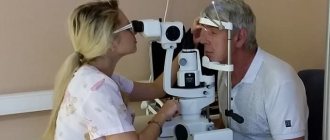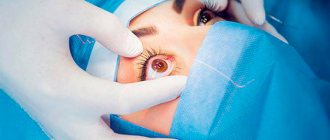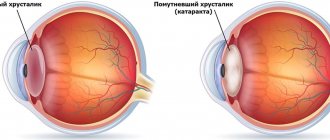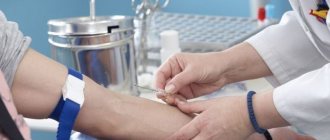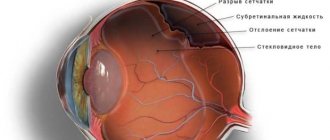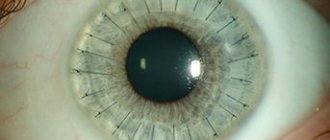After cataract surgery, on what day are you discharged from the hospital?
Today, cataract surgery is considered low-traumatic and is performed on an outpatient basis. However, the patient is still entitled to sick leave for the entire rehabilitation period. Despite the fact that the patient returns to normal life the very next day, for a complete recovery it is necessary to follow some rules - do not lift heavy things, protect your eyes from dust and dirt, avoid hypothermia, etc.
d. Not every job makes it possible to follow these restrictions, and sick leave is issued precisely in order to avoid complications and allow the body’s tissues to fully recover. The Eye Surgery Clinic issues an extract after the operation, on the basis of which a certificate of incapacity for work can be obtained at the clinic for a period of at least 10 days.
Sick leave after cataract surgery and lens replacement is issued at the institution where the treatment was carried out or at the clinic. If rehabilitation requires more time, the period of incapacity may be extended. The b/l is extended either upon repeated contact with the attending physician, or in the clinic at the place of residence in the ophthalmology office.
How many days of sick leave are given after cataract removal depends on many factors.
The main ones: 1) The success of the operation.
The surgeon examines the operated eye and determines the possibility of complications.
2) Method of treatment. With lens extraction, release from work is given for a longer period than with phacoemulsification,
Maximum duration
Issues related to the insurance itself and the payment of compensation during illness are regulated by Federal Law No. 255 “On compulsory social insurance in case of disability.” In particular, it talks about the duration of sick leave. The law sets maximum periods for various cases. The maximum does not determine the obligation to close the sick leave after the specified time, but indicates that the patient will have to renew the form in a different way.
The maximum periods specified in Federal Law-255 are calculated based on general medical practice and the recovery periods of patients. If for some reason the patient is not cured within the allotted period, he must undergo additional examinations and members of the medical commission will discuss the further extension period and the nuances of treatment.
A sick leave can be issued by a doctor for 15 days; if it is issued by a paramedic, the duration is reduced by five days. Such periods are used for common diseases, for which this period is more than enough. However, there are other diseases or injuries that require much more time to restore body functions.
The following are allocated for recovery:
- Up to 15 days for colds such as ARVI, sore throat, flu.
- Up to 3 weeks with chickenpox.
- 20-28 days if a concussion occurs.
- For fractures and injuries until recovery. Most often, fractures of the limbs take up to 2 months, and of the spine up to 8 months.
- Oncological diseases are treated until a positive result is achieved, but most often they are given up to six months.
- For tuberculosis patients, sick leave can be extended up to a year.
The recovery period for surgical interventions is determined by the disease that led to the operation and the degree of complications after it.
As can be seen from the above figures, the maximum duration of incapacity for work can be considered a period of one year. If the medical commission determines that the patient is not recovering and his body is not recovering, then we are talking about recognizing his partial or complete disability and assigning him a disability group.
This is important to know: How to get a certificate of incapacity for work to care for an adult
Cataract surgery sick leave
May 20, 2021 adminVitamins Contents:
- Sick leave after cataract surgery. Where can I get it? Duration for which the patient is released from work Conditions for obtaining sick leave Do they provide sick leave after cataract surgery in private clinics? Let's summarize. Rules of behavior in the postoperative period after replacing the lens of the eye? How does the operation proceed? Possible complications Hospital payments: what should an employee expect after surgery? Who determines the length of sick leave after surgery Maximum and minimum sick leave Duration of sick leave for various types of operations Cataract removal: extracapsular, intracapsular extraction and phacoemulsification Diagnosis and types of surgical interventions Cataract surgery Causes Symptoms Diagnosis Types of operations Preparation for surgery Performing surgery Rehabilitation Recommendations Non paid operationCost of the operation Sick leave after cataract surgery.
Today, cataract surgery is considered low-traumatic and is performed on an outpatient basis. However, the patient is still entitled to sick leave for the entire period of rehabilitation. Despite the fact that the patient returns to normal life the very next day, for complete recovery it is necessary
Medical and social examination
Code according to ICD-10 Line number according to form N 16-VN Name of the disease according to ICD-10 Features of the clinical course of the disease, type of treatment, etc. Approximate terms of VN (in days) 1 2 3 4 5 H00-N06 Diseases of the eyelids, lacrimal ducts and orbits H00.1 27.28 Chalazion Inflammation 15-10 Operation 7-14 H04.0 27.28 Dacryoadenitis 10-12 H04.3 27.28 Dacryocystitis 14-20 H04.4 27.28 Chronic inflammation of the lacrimal ducts Exacerbation 7-10 H05.0 27.28 Acute inflammation of the orbit 30-45 H05.1 27.28 Chronic inflammatory diseases of the orbit Exacerbation 25-35 H10-H13 Diseases of the conjunctiva H10.0 27.28 Mucopurulent conjunctivitis 7-12 H10.4 27.28 Chronic conjunctivitis Exacerbation 3-14 H10.5 27.28 Blepharoconjunctivitis 5-10 H15-H22 Diseases of the sclera, cornea, iris and ciliary body H15.0 27.28 Scleritis 6-12 H15.1 27.28 Episcleritis 7-14 H16.0 27.28 Corneal ulcer 30-45 H16.2 27.28 Keratoconjunctivitis 20-30 H20.0 27.28 Acute and subacute iridocyclitis 14-25 H20.1 27.28 Chronic iridocyclitis Exacerbation 18-30 H21.1 27.28 Others vascular diseases of the iris and ciliary body 14-35 N21.3 27.28 Cyst of the iris, ciliary body and anterior chamber of the eye Operation 15-25 H21.5 27.28 Other types of adhesions and ruptures of the iris and ciliary
Proper rehabilitation after cataract surgery
Treatment for a significantly clouded lens and impaired quality of vision is only possible with surgical intervention.
Any operation involves a postoperative period, cataract is no exception, although the area of the operation is very small, but even here it is very important to pay attention to proper rehabilitation.
The first six months after cataract removal are considered the postoperative period.
The complexity and severity of its course depend on the patient’s responsibility, scrupulousness in following medical recommendations for rehabilitation, as well as the stage of the cataract and the method of surgery. Stages of rehabilitation in the postoperative period:
- The next five months are the postoperative rehabilitation period, during which visual acuity is completely restored and stabilized, and long-term complications also appear.
- The first month - as a rule, no more than this number of days is given maximum sick leave. It is assumed that during this time the body will have time to recover sufficiently to return to work.
- The early postoperative period is the first day after surgery, indicating the degree of its success and effectiveness.
- The first week is a risk zone for infection, disruption of the placement of the intraocular lens and other complications.
It is impossible to say exactly the duration of each rehabilitation period after cataract surgery; this is an individual indicator that depends on many factors:
Additional restrictions after laser vision surgery
In addition to the key limitations during the recovery period after vision surgery, there are a number of additional, but very important contraindications.
- Sports and physical activity
So, the patient should significantly reduce physical activity, and also completely eliminate:
- run;
- exercises in the gym;
- game and contact sports;
- gymnastic exercises and exercises.
Most often, this ban is one of the last to be lifted upon full recovery after laser vision correction. A person should return to their usual activities gradually.
- Drinking alcoholic beverages
Due to the fact that alcohol can provoke inflammatory processes in the body and significantly slow down the healing of the visual organs after laser vision correction, ophthalmologists strictly do not recommend its use during the three-month rehabilitation period.
- Working at a computer, reading and using gadgets
The use of electronic devices that promote high visual concentration, as well as reading, should be completely avoided in the first days after the operation. In the future, the patient is allowed to do this in small quantities, gradually increasing the load on vision. Thus, contraindications are removed individually, depending on the condition of the patient’s eyes; it is recommended to start with 1-2 hours, increasing the limit by 10-15 minutes per day. It is recommended to reduce the brightness on the monitor and gadget screens.
- Driving a vehicle
During the rehabilitation period after laser vision surgery, you should start driving no earlier than after one week. It is very important to get used to new optical conditions; for this, the patient should travel on lightly congested roads or empty areas. Some drivers, after laser vision correction, begin to feel the dimensions of the car and the distance of objects in a new way. You should avoid driving in the dark for a month, since at dusk the visual organs are affected by halos, reflections, glare, and headlights.
- Age contraindications for surgery
Laser correction for vision restoration is considered accessible to patients aged 18 to 45 years. Experts explain such limitations by the fact that in children under 18 years of age the visual system continues to develop, the size of the eyeball and refractive indices change, so the operation will be completely ineffective. In adulthood, after 45 years, ophthalmologists warn a person that the procedure is not a guarantee against the appearance of presbyopia (age-related farsightedness).
Such age restrictions on carrying out procedures to improve vision are still conditional; in each specific case, the doctor makes a decision individually.
How long is sick leave after a cataract?
03/11/2021 admin Contents:
- Recovery and rehabilitation after cataract surgery Postoperative period Limitations and contraindications Regime and rules Possible complications Is sick leave given after cataract surgery? Cataract surgery. How long does the postoperative period last, complicationsHow long does rehabilitation last after cataract removalBasic rules for rehabilitation after surgeryHow to properly instill eye drops during the rehabilitation periodWhat cannot be done in the postoperative period after cataract surgeryWhat to do if complications occurWhat further eye care after cataract removalLength of sick leave after surgeryHow much leave is after surgery according to the Labor Code of the Russian Federation? Sick leave after abdominal surgery, how many days? Duration of sick leave after surgery - how many days Contents Who and how establishes the duration of sick leave Duration of sick leave after various operations Sick leave after cataract surgery. Where can you get it? Periods for which the patient is released from work Conditions for obtaining sick leave Give Is there sick leave after cataract surgery in private clinics? Let’s summarize. The recovery period after cataracts. Recovery and rehabilitation after cataract surgery.
Duration of sick leave
The type of pathology is the main factor in determining the duration of disability. The Letter of the Ministry of Health of the Russian Federation No. 2510 indicates the approximate time a citizen will spend under treatment depending on the disease:
| Type of pathology | Duration of sick leave (days) |
| Cold | 5-15 |
| Angina | 10-15 |
| Limb fracture | 30-60 |
| Spinal injury | 60-240 |
| Brain concussion | 20-28 |
| Oncology | 120-180 |
| Tuberculosis | 4-10 months |
| Chickenpox | 10-21 |
| Inflammation of appendicitis | 16-21 |
| Cyst removal | 20-28 |
| Tooth extraction | 3-10 |
| Pinched nerve | 5-21 |
| Attack of hypertension | 5-15 |
| Hernia removal | 20-60 |
| Bypass surgery | 30-60 |
| Hemorrhoid removal | 3-10 |
The length of sick leave after surgery depends on the complexity of the procedure. The period allotted for restoration of health is influenced by the type of pathology. An officially employed citizen has the right to issue a form to care for a close relative. For outpatient treatment of an acute or chronic illness of a child under 7 years of age, the employee is provided with paid time off for the entire period of stay in the medical institution. If the minor is between 7 and 15 years old, the period of the certificate of incapacity for work is valid for up to 15 days with a possible subsequent extension.
How many days is sick leave for cataracts?
Contents: Today, cataract operations are considered low-traumatic and are performed on an outpatient basis.
However, the patient is still entitled to sick leave for the entire period of rehabilitation. Despite the fact that the patient returns to normal life the very next day, for a complete recovery it is necessary to follow some rules - do not lift heavy things, protect your eyes from dust and dirt, avoid hypothermia, etc.
d. Not every job makes it possible to follow these restrictions, and sick leave is issued precisely in order to avoid complications and allow the body’s tissues to fully recover. The Eye Surgery Clinic issues an extract after the operation, on the basis of which a certificate of incapacity for work can be obtained at the clinic for a period of at least 10 days. Sick leave after cataract surgery and lens replacement is issued at the institution where the treatment was carried out or at the clinic.
If rehabilitation requires more time, the period of incapacity may be extended. The b/l is extended either upon repeated contact with the attending physician, or in the clinic at the place of residence in the ophthalmology office. How many days of sick leave are given after cataract removal depends on many factors. The main ones: 1) The success of the operation.
The surgeon examines the operated eye and determines the possibility of complications. 2) Method of treatment. During lens extraction, release from work is given for a longer period than during phacoemulsification, since the latter operation is less traumatic.
3) The patient has concomitant diseases - glaucoma, astigmatism, diabetes.
Temporary disability
Working citizens who fall ill should contact medical institutions to receive qualified care. The doctor not only makes a diagnosis and prescribes appropriate treatment, but also issues a sick leave certificate, which is extremely important for working people. A completed ballot is the basis for not losing your job and receiving monetary compensation for the entire duration of your illness.
When establishing the terms of the certificate of incapacity for work, the doctor is guided, first of all, by legislative norms that regulate the possible duration of the issued form, depending on the established diagnosis. When issuing a ballot, there are several unshakable rules:
- The form can only be issued in a hospital or clinic by a local or attending physician.
- For outpatient treatment, a certificate of incapacity for work is issued by a doctor for no more than 15 days, and by a dentist for 10 days.
- The duration of inpatient treatment is determined by the diagnosis.
Extension of the maximum permissible terms can only be made on a commission basis.
Lens replacement for cataracts, sick leave
Today, cataract surgery is considered low-traumatic and is performed on an outpatient basis.
However, the patient is still entitled to sick leave for the entire rehabilitation period. Despite the fact that the patient returns to normal life the very next day, for a complete recovery it is necessary to follow some rules - do not lift heavy things, protect your eyes from dust and dirt, avoid hypothermia, etc. Not every job makes it possible to follow these restrictions, and sick leave is issued precisely in order to avoid complications and allow the body’s tissues to fully recover.
The Eye Surgery Clinic issues an extract after the operation, on the basis of which a certificate of incapacity for work can be obtained at the clinic for a period of at least 10 days. Sick leave after cataract surgery and lens replacement is issued at the institution where the treatment was carried out or at the clinic.
If rehabilitation requires more time, the period of incapacity may be extended. The b/l is extended either upon repeated contact with the attending physician, or in the clinic at the place of residence in the ophthalmology office.
How many days of sick leave are given after cataract removal depends on many factors. The main ones: 1) The success of the operation.
The surgeon examines the operated eye and determines the possibility of complications.
2) Method of treatment. With lens extraction, release from work is given for a longer period than with phacoemulsification,
Procedure for paying temporary disability benefits
Sick leave is paid by the employer. The amount of the benefit depends on the person’s length of service and the number of days spent in outpatient or inpatient treatment.
Payment is made on the basis of a disability certificate completed and certified by the seal and stamp of the medical institution. Within 10 days after granting sick leave, the employer must calculate the employee's due payment. The benefit is accrued as a supplement to the next salary or advance payment.
Thus, the decision to issue sick leave after surgery is made by the doctor. The type and method of surgical intervention and the patient’s general health are taken into account. For minor operations, they may be released from work for 3-15 days. After severe manipulations, recovery can last from 3-4 to 12 months.
Sick leave after cataract surgery
Contents: Today, cataract operations are considered low-traumatic and are performed on an outpatient basis. However, the patient is still entitled to sick leave for the entire rehabilitation period.
Despite the fact that the patient returns to normal life the very next day, for a complete recovery it is necessary to follow some rules - do not lift heavy things, protect your eyes from dust and dirt, avoid hypothermia, etc. Not every job makes it possible to follow these restrictions, and sick leave is issued precisely in order to avoid complications and allow the body’s tissues to fully recover.
The Eye Surgery Clinic issues an extract after the operation, on the basis of which a certificate of incapacity for work can be obtained at the clinic for a period of at least 10 days.
Sick leave after cataract surgery and lens replacement is issued at the institution where the treatment was carried out or at the clinic. If rehabilitation requires more time, the period of incapacity may be extended.
The b/l is extended either upon repeated contact with the attending physician, or in the clinic at the place of residence in the ophthalmology office. How many days of sick leave are given after cataract removal depends on many factors.
The main ones: 1) The success of the operation. The surgeon examines the operated eye and determines the possibility of complications.
Conditions for obtaining sick leave
You should not think that a certificate of incapacity for work is issued after the operation in any case. Sometimes a doctor can completely rightfully refuse you. This happens if the patient does not comply with the recommendations on the regimen (for example, drinks alcohol, does not take prescribed medications (does not instill drops), does not visit an ophthalmologist on time. Also, before surgery, it is necessary to take tests and undergo the necessary examinations. Keep in mind that sick leave may not be extended if you show up for a follow-up appointment later than the end date of the first b/l.
How many days do you have sick leave after cataract surgery?
Today, cataract surgery is considered low-traumatic and is performed on an outpatient basis.
2) Method of treatment. During lens extraction, release from work is given for a longer period than during phacoemulsification, since the latter operation is less traumatic. 3) The patient has concomitant diseases - glaucoma, astigmatism, diabetes.
However, the patient is still entitled to sick leave for the entire rehabilitation period.
Despite the fact that the patient returns to normal life the very next day, for a complete recovery it is necessary to follow some rules - do not lift heavy things, protect your eyes from dust and dirt, avoid hypothermia, etc. Not every job makes it possible to follow these restrictions, and sick leave is issued precisely in order to avoid complications and allow the body’s tissues to fully recover.
The Eye Surgery Clinic issues an extract after the operation, on the basis of which a certificate of incapacity for work can be obtained at the clinic for a period of at least 10 days. Sick leave after cataract surgery and lens replacement is issued at the institution where the treatment was carried out or at the clinic.
If rehabilitation requires more time, the period of incapacity may be extended. The b/l is extended either upon repeated contact with the attending physician, or in the clinic at the place of residence in the ophthalmology office. How many days of sick leave are given after cataract removal depends on many factors.
The main ones: 1) The success of the operation. The surgeon examines the operated eye and determines the possibility of complications.
2) Method of treatment. With lens extraction, release from work is given for a longer period than with phacoemulsification,
Is a certificate of incapacity issued after plastic surgery?
Plastic surgeries are performed to solve aesthetic problems that prevent a person from leading a full life and working activity. In this case, the patient can count on receiving release from work.
For example, if, due to a crooked septum in the nose, a patient has breathing problems or due to an abnormal structure of the oral cavity, a person cannot eat normally, then a paid certificate of incapacity for work is issued. The complexity of the operation must also be taken into account.
For example, rhinoplasty is a minor type of surgery. A few days are enough for the swelling and pain to go away. If breast or abdominal surgery is performed, the woman will be unable to work for some time. She has the right to take sick leave.
This is important to know: What is the formula for calculating temporary disability benefits?
It's fast and free!
Dear readers! Our articles talk about typical ways to resolve legal issues, but each case is unique.
If you want to find out how to solve your particular problem, please use the online consultant form on the right or call:
It's fast and free!
How much sick leave do you get after eye surgery?
Our readers successfully use Oko-plus to treat joints. Seeing how popular this product is, we decided to bring it to your attention.
- The presence of ailments in the form of glaucoma (is chronic), cataracts (clouding of the lens occurs), keratoconus (the cornea is convex and resembles a cone).
- Progressive myopia.
- Any changes in the fundus.
- Previous treatment for retinal detachment using surgery.
- Incurable blindness.
- Dry eye syndrome.
- Iridocyclitis.
- Alcoholism and drug addiction of a severe type.
- Acute diseases such as arthritis and collagenosis.
- Weakening of immune function.
- Mental disorders.
- The presence of unstable refraction.
- Under eighteen years of age. The thing is that the child’s body is still going through the formation stage. And the operation may be pointless due to a possible relapse.
- Performing surgery on only one visual organ.
- The period of bearing a baby and breastfeeding.
- Diabetes.
- Dystrophy of the retina.
- Inflammatory eye diseases.
But experts say that even with one of the above diseases, you should not lose hope.
Read more here... Contraindications to laser vision correction include the following points.
Every year, technologies are improving, which will make it possible to perform laser vision correction for any critical illness.
